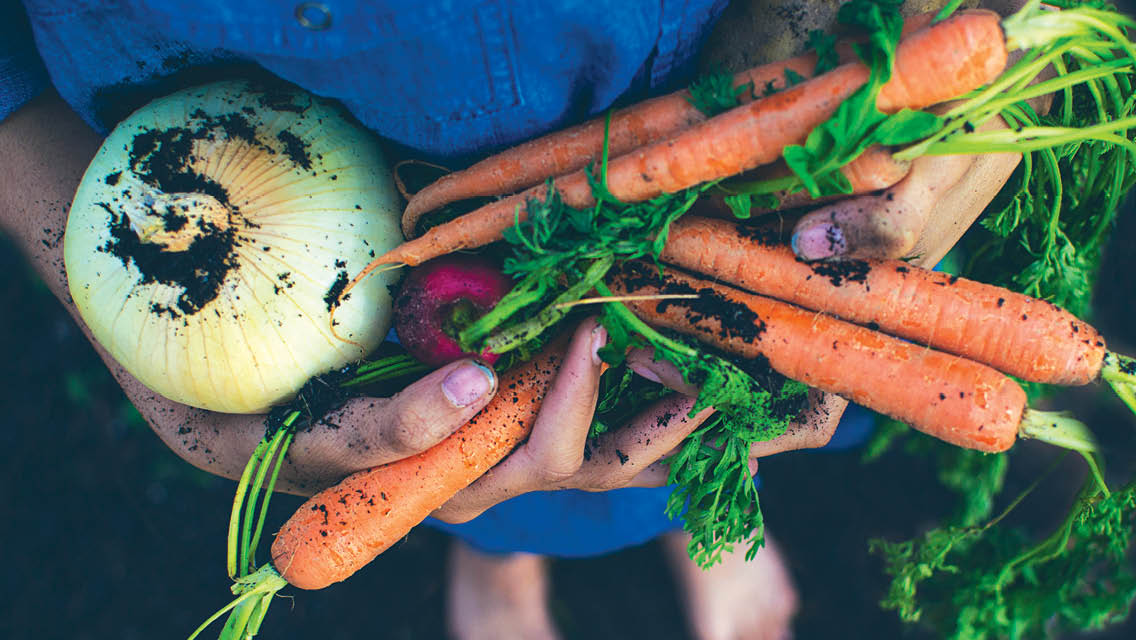Like most farmers, Mac Stone thinks about the future when he looks out over his acreage. But he’s not just planning for the harvest. He’s thinking generations ahead.
“We brought this farm back from conventional tobacco by transitioning to organic more than 25 years ago,” he says. “Everything we’ve done since then has been about creating a diverse operation and improving soil health. This is a sixth-generation farm: We want it to be even better for the ones farming it next.”
Along with his wife and brother-in-law, Stone runs Elmwood Stock Farm near Lexington, Ky. The farm is more than a community-supported agriculture (CSA) program — although it certainly has that, with more than 800 members and 40 different types of vegetables and herbs, as well as beef cattle, pigs, ewes, laying hens, broiler chickens, and heritage turkeys.
At Elmwood, they let animals graze freely. They rotate pastures and fields so they’re not constantly producing and getting depleted, caring for the land even when it’s at rest. They plant cover crops to prevent soil erosion and to bolster fertility. They’re smart about water, and they support pollinators and avoid chemical sprays.
This breadth of strategies is all part of regenerative agriculture.
“These are farming practices that reduce reliance on the things that might harm what’s needed to produce food, so you’re more conscious of water, soil, and the carbon cycle,” says Brian DeVore, editor at the Minnesota-based Land Stewardship Project and the author of Wildly Successful Farming: Sustainability and the New Agricultural Land Ethic. “Think of it not as a food cycle, but more like a food web. Everything is connected to everything else. How you treat one thing will affect everything else in that web.”
A lot of public attention has been paid to organic-farming practices, which remain important, says DeVore. But regenerative farming takes sustainability to another level.
It isn’t about simply growing produce that’s free from chemical sprays. In many ways, regenerative agriculture is a return to the way people used to farm, with an understanding of how all the different elements of a farming system work together.
“We’re letting nature take the lead: We’re partnering with it, instead of constantly fighting against it,” says Minnesota farmer Dayna Burtness. “This creates resiliency in every possible way, from better soil to healthier animals to cleaner water to stronger rural communities.”
These benefits also extend to human health. The connection is so direct that Jeff Tkach, chief impact officer at Rodale Institute, a 70-year-old nonprofit dedicated to sustainable farming, sees a direct connection between regenerative agriculture and the practice of functional medicine.
In conventional medicine, doctors treat symptoms; in conventional agriculture, farmers use chemicals to chase symptoms like pests and weeds, he explains. But in functional medicine, physicians view people as systems — just as regenerative agriculture sees soil as a system.
“Our job as farmers is to produce healthy people,” Tkach says.
Unlike organic farming, regenerative agriculture doesn’t adhere to a set of guidelines or have a certification, explains DeVore, which makes it difficult to estimate how many farmers are following these practices. But he believes one thing is certain: It’s booming — and that’s a good thing, for many reasons. These are some of them.
Better soil means better everything.
Regenerative farmers think about soil and its health every day, because it determines the health of everything that’s grown in and on it.
On many farms, soil health is routinely depleted by relentless cycles of intense fertilization and growing one type of crop, which then extracts soil nutrients. This is monocrop farming.
On a regenerative farm, soil is treated like the valuable, living ecosystem that it is. It’s nourished with natural fertilizers and hoof action from animals; pests are managed with plant diversity rather than chemicals; and fields are periodically rested. Limited tilling helps keep nutrients and moisture in the soil rather than sacrificing them to exposure.
All of this produces benefits that extend beyond the health of the soil. “The result is that you sequester carbon in the soil due to less erosion, and that keeps it out of the atmosphere,” says DeVore.
Regenerative farming uses a year-round living root system to capture and store carbon dioxide in the soil, where it belongs, instead of releasing it into the atmosphere as greenhouse gases.
Happy animals are healthier animals.
At Nettle Valley Farm, where Burtness and her husband, Nick Nguyen, raise pastured pigs, their regenerative approach puts the animals in charge.
“Pigs know how to be pigs better than I do,” she says. “We’ve spent years watching to see what they like, what makes them happy, and we’ve put systems in place to support that.”
For example, the pigs can roam freely but have protective shelter from cold, rain, and heat. They’re offered organic feed but have diverse pastures to graze as well. Most of all, they have space to play.
“Before we started raising pigs, I didn’t realize how playful they are. They love doing zoomies and goofing around with each other,” she says. “While it’s true that they’re being raised to become meat, they are experiencing maximum pig happiness up until their one bad day.”
Burtness isn’t striving to grow the pigs as large as possible to maximize profit nor retain the pigs in limited areas to expand the farm’s overall operation. Although economic sustainability is crucial, she believes they can achieve it by being “pig-happiness managers.”
“When you have unhappy animals in confined conditions, they get stressed and sick — that’s just what happens,” she says. “So, you’re spending all this money and effort on fighting against that. It’s an unhealthy system for the pigs and the land, not to mention the farmer.”
Raising animals in concentrated animal feeding operations (CAFOs) leads to a range of health concerns for the animals as well as processing-plant workers and consumers. The Centers for Disease Control notes that manure in CAFOs contains multiple potential contaminants, including E. coli, growth hormones, antibiotics, and chemicals used to clean equipment. (For more on CAFO concerns, see “The CAFO Conundrum“.)
For Stone and others who pasture-raise their stock, the animals’ chemical-free manure plays an integral role in soil health. The animals walk on their waste, breaking it down; beneficial insects like dung beetles process it even more. The manure becomes natural fertilizer supporting the soil ecosystem, and this in turn creates nutrient-rich pastureland for the animals to graze on, fortifying the meat and dairy they produce.
Even vegans benefit. Regenerative agriculture’s reliance on animals raised with traditional methods leads to vegetables and fruits grown in more nutrient-rich soil.
Nutrient density from farm to fork.
All that luscious, rich, vibrant, nutrient-packed soil translates into what you eat, says integrative eco-dietitian Mary Purdy, RDN.
“Pesticides can have an impact on the microbiome of the soil, which, like our own microbiome, is a communication system,” she says. “When that’s compromised, the soil can become depleted. So what you’re eating might have fewer nutrients, specifically phytonutrients — healthy plant chemicals — than that same kind of vegetable grown through regenerative agriculture.”
Produce grown in healthy soil not only provides beneficial bacteria and microorganisms that feed our own microbiome, it also can provide higher levels of numerous micronutrients that have a direct impact on how our bodies function, Purdy explains.
Cognitive activity, immune health, cardiovascular performance, hormone regulation, inflammation control — the list of physiological functions affected by vitamins and minerals is long. And getting those nutrients from food is ideal, she adds.
“The health of the ecosystem in which our food grows directly affects the ecosystem of our gut and the rest of our body,” says Purdy.
Cleaner water, all the way downstream.
In the Gulf of Mexico, there’s a dead zone of limited oxygen, where no fish or marine life can survive. The National Oceanic and Atmospheric Administration estimated in 2019 that it covers about 8,000 square miles — roughly the size of Massachusetts. One of the primary causes is chemical runoff from Midwestern farms, more than 1,000 miles away.
Rivers, lakes, groundwater, streams, and aquifers also get polluted via runoff from farm fields that are rife with synthetic fertilizers and chemicals. Because these fields are continually farmed, the soil becomes compacted, provoking runoff. And a lack of cover crops, which are used to secure soil during nongrowing periods, exacerbates erosion.
Healthy soil that’s managed with cover crops and reduced tillage is more resilient. DeVore notes that regenerative farms often grow vegetation around their fields, such as trees and other plants, that help with water conservation.
Pollinators can thrive.
The alarm over declining bee populations is warranted, and many experts believe pesticides are a major contributor to “colony collapse disorder.” Still, simply switching to organic is not enough to bring bees back if those farmers are growing a monocrop on hundreds of acres.
Large-scale organic operations often lack the plant diversity necessary to support bees and other beneficial pollinators, such as butterflies, wasps, beetles, moths, and even bats. If pollinator populations don’t have a variety of plants to pollinate, they can’t survive.
“Without pollinators, we don’t eat — it’s as simple as that,” wrote Sonny Ramaswamy, director of the National Institute of Food and Agriculture, in a 2017 call to action published by the USDA. “And at the moment, large numbers of pollinators are dying. With the world’s population projected to exceed 9 billion in just the next 30 years or so, that is not a good position for us to be in.”
Healthy soil, clean water, and fields with animals roaming them, depositing all their lovely fertilizer — these are environments where plant diversity blooms, says DeVore. They attract pollinators and ensure a robust food web. (For more on what you can do to protect pollinators, see “9 Ways to Help Pollinators“.)
Closer connection to nature.
When Burtness watches her pigs play, when Stone scoops up a handful of rich soil, when DeVore visits a farm abuzz with pollinators, when Purdy roasts vegetables grown by someone she knows — they all feel a connection to that food web. But it’s not just farmers and their advocates who can enjoy that feeling; the rest of us can too, though it may take more effort.
“Unfortunately, many of us feel separated from what we’re eating,” says Diana Rodgers, RD, dietitian at Sustainable Dish and director of the documentary Sacred Cow. “That is especially true with meat, because we’ve developed biases based on what we believe to be true nutritionally, ethically, and environmentally. Understanding the food web makes us feel less disconnected to what we’re eating.”
Just as organic farming focused attention on the use of chemicals in agriculture, Rodgers notes, regenerative agriculture is helping people understand the different elements of the food web and their place within it.
Traditions are preserved.
Regenerative agriculture may be a new term, but it’s an ancient practice, using many farming systems developed by Indigenous and African heritage people, says Larisa Jacobson, codirector at Soul Fire Farm in Petersburg, N.Y.
“This type of farming, which builds resilience and is beneficial for the land and the climate, has been done for generations around the world,” Jacobson explains. For instance, the use of rotational grazing, cover crops, and intercropping (the cultivation of two or more kinds of crops in the same field) are all traditional practices.
“By using these methods, we’re celebrating the people who came before us; we’re acknowledging their brilliance,” she says.
Rural communities get stronger.
Farmers and their customers prosper from a successful regenerative-agriculture venture, but it doesn’t stop there, says DeVore. The people who run the local hardware store also benefit, as does the mechanic who keeps the tractors running, and on and on, throughout the community.
“Rather than these mega factory farms that don’t contribute much to a local economy, regenerative farmers are very focused on creating healthy communities,” he says.
For example, Stone employs numerous workers. They package CSA shares, staff the farmers’ market, and make deliveries. These workers, in turn, are likely to live in the community and spend their money there. Not to mention that the local environment is improved through the farm’s focus on clean water and clean soil.
“The big-picture view with regenerative agriculture is that everything is connected to everything else,” says DeVore. “That includes us. When we come back to the point of respecting the land, the animals, and the farmers, then we all benefit.”
How You Can Support Regenerative Agriculture
- Know your farmer. Research local farms to learn about their pest-management protocols, regenerative practices, and overall philosophy. Keep in mind that many farmers who avoid chemical pesticides may not apply for organic certification; it’s expensive, and many small farms can’t afford it.
- Buy pastured meat and eggs and grassfed dairy. Your purchase of regenerative products sustains these farms.
- Dine at restaurants that support farmers. Tell restaurant owners you appreciate their focus on meats, dairy, and produce from regenerative farms.
- Volunteer at a farm. Many farmers appreciate having volunteer labor, and in some cases, you can bring kids, too.
- Consider a community-supported agriculture (CSA) share. Produce or meat shares provide money upfront for operations so farmers can handle early-season costs like seeds, equipment, and feed.
The Challenge of Land Access
Among the promises of regenerative practices there remains a significant challenge: inequity of land access.
Access has been tough for young farmers for a long time, especially as mega farms scoop up farmland for expansion. It’s even more difficult for people of color. According to a recent report from the National Young Farmers Coalition, white people own 98 percent of U.S. farmland.
“Land accessibility is a huge issue for Black and brown farmers,” says Soul Fire Farm’s Larisa Jacobson. “The question becomes, ‘How can we decolonize agriculture? How can we acknowledge where the majority of the opportunity, capital, agricultural education, policy supports, and financial and technical assistance go?’ That’s a big question, but it starts with seeing that this is a problem.”
This article originally appeared as “Back to the Land” in the July/August 2021 issue of Experience Life.





This Post Has 2 Comments
Elizabeth,
I wish your article had not included the challenge of land access comments.
If the important point is sustainability of the soil and how everything is connected through systems-which I agree. Land access is complicated and ignores that all systems compete.
Is this article about food and health or bringing in a moral judgement about race and wealth?
You might be right but is anything in nature about fair and equitable or does nature reward the path that has the most adaptability? Who settled the land first and why can be explained by colonization, or it can be viewed as a large evolving system with uncontrollable population growth putting ever greater demands to sustain itself. Nature doesn’t react well to imbalances. The issues you raise have more to do with population than to race.
[…] “Cruelty-Free”: Neither the FDA nor USDA oversees the use of this term in advertising, so other groups have stepped in. The agricultural organization A Greener World, which also certifies organic, grassfed, and non-GMO products, awards the Animal Welfare Approved label to independent farms where animals are raised outdoors on pasture or range for their entire lives and are slaughtered humanely. These farms must also practice sustainable growing techniques. […]